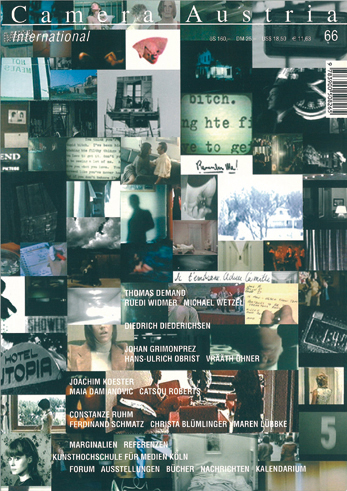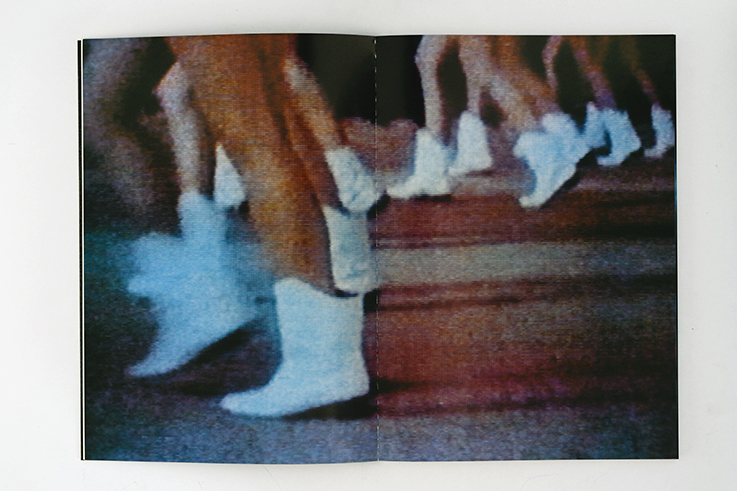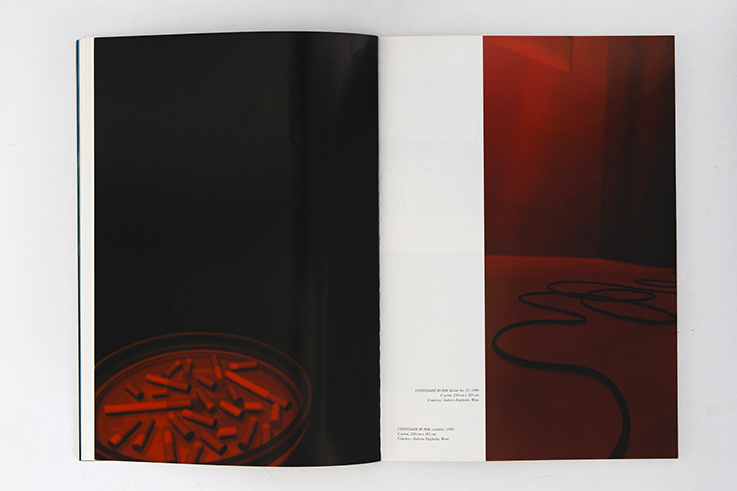Camera Austria International
66 | 1999
- MICHAEL WETZEL
Photography as a Craft and as Mythology. Thomas Demand’s “Zeigzeugenschaften” - RUEDI WIDMER
Thomas Demand: Building the Scene of Crime. An interview by Ruedi Widmer - DIEDRICH DIEDERICHSEN
Photography and Remembrance: Feldmann, RAF, Schlick, Kippenberger etc. - VRÄÄTH ÖHNER
On Seeing, Flying and Dreaming. "dial H-I-S-T-O-R-Y" by Johann Grimonprez - JOHAN GRIMONPREZ
- HANS-ULRICH OBRIST
Interview with Johan Grimonprez - MAIA DAMIANOVIC
Interview mit Joachim Koester - CATSOU ROBERTS
Joachim Koester: Blue Haze: Images from a Recent Dream
- JOACHIM KOESTER
- FERDINAND SCHMATZ
Constanze Ruhm: Umgesetzte Gebung - CHRISTA BLÜMLINGER
Constanze Ruhm: Das Trauma feststellen - MAREN LÜBBKE
The Logic of the Obliterated Moment. Constanze Ruhm interviewed by Maren Lübbke - CONSTANZE RUHM
- ROLF SACHSSE
Marginalien zur bundesdeutschen Fotografie - WOLFGANG VOLLMER
Referenzen

Preface
We have dubbed the realization of this edition of CAMERA AUSTRIA “Tatort” or “Scene of the Crime.” “Tatort” denotes a scene charged with meaning by an incident that has transpired upon it. Our subject here, of course, is not that of documentary crime scene photography – rather, crime scenes prompt us to search after clues, force us to think, and call upon us to perform a labor of consciousness or memory. With this, characteristic images spring to mindimages familiar to everyone; images that have planted themselves in our heads and that have the power to move us. Whence do such images come, how are they composed, and, above all, what forms of transference are responsible for the development of this “visual reservoir” over which a kind of collective consciousness manifests itself? The artists we introduce in this issue – Thomas Demand, Johan Grimonprez, Joachim Koester, and Constanze Ruhm – and the writer, Diedrich Diederichsen – are all concerned with the origin and “survival” of crime scene images in the collective memory, or, as the case may be, the mass media. They thematize the mechanisms of these processes – those concatenations, shifts, and spaces that shape the politics of news reporting, the forms of remembrance, and the narrative structure of the cinema. At the same time, the works presented here move in full consciousness along the narrow ridge between document and drama, between fiction and reality – on the one hand, they are critical-reflexive; on the other hand, subjective-suggestive. The basis for Thomas Demand’s photographic and recent cinematic work is the media-transmitted and collectively remembered reservoir of images of specific crime scenes (such as the “Barschel-bathroom,” or Hitler’s headquarters) but also of banal, seemingly meaningless places (such as balconies, or garages). Demand reconstructs such spaces in paper and photographs them. In a reduction process, he follows the “code of authenticity:” His models (and his pictures) confine themselves to the essential information necessary for building this space as type – standing between, as it were, the supposed authentic crime scene (image) and the mundane. For CAMERA AUSTRIA, Demand has put together a series of stills from his first film, “Tunnel,” (also) an allusion to the tunnel in which Diana met her death. Constanze Ruhm, too, works with the denudation of image space. The starting point of her work, however, is the cinematic “fiction machine,” taking scenes from films by Jean-Luc Godard and François Truffaut, which she then reduces to architecture and light in her computer-generated works. The analysis of a clip of cinematic styles thereby functions as a suggestive platform: The borrowed film material serves her as the projection film for a second (open) story that is superimposed over an existing one. Constanze Ruhm is currently at work on number 7 in CAMERA AUSTRIA’s “Edition” series, which will be available through our editorial offices beginning in July.
Manfred Willmann and Team
June 1999
Camera Austria International 66 | 1999
Preface
We have dubbed the realization of this edition of CAMERA AUSTRIA “Tatort” or “Scene of the Crime.” “Tatort” denotes a scene charged with meaning by an incident that has transpired upon it. Our subject here, of course, is not that of documentary crime scene photography – rather, crime scenes prompt us to search after clues, force us to think, and call upon us to perform a labor of consciousness or memory. With this, characteristic images spring to mindimages familiar to everyone; images that have planted themselves in our heads and that have the power to move us. Whence do such images come, how are they composed, and, above all, what forms of transference are responsible for the development of this “visual reservoir” over which a kind of collective consciousness manifests itself? The artists we introduce in this issue – Thomas Demand, Johan Grimonprez, Joachim Koester, and Constanze Ruhm – and the writer, Diedrich Diederichsen – are all concerned with the origin and “survival” of crime scene images in the collective memory, or, as the case may be, the mass media. They thematize the mechanisms of these processes – those concatenations, shifts, and spaces that shape the politics of news reporting, the forms of remembrance, and the narrative structure of the cinema. At the same time, the works presented here move in full consciousness along the narrow ridge between document and drama, between fiction and reality – on the one hand, they are critical-reflexive; on the other hand, subjective-suggestive. The basis for Thomas Demand’s photographic and recent cinematic work is the media-transmitted and collectively remembered reservoir of images of specific crime scenes (such as the “Barschel-bathroom,” or Hitler’s headquarters) but also of banal, seemingly meaningless places (such as balconies, or garages). Demand reconstructs such spaces in paper and photographs them. In a reduction process, he follows the “code of authenticity:” His models (and his pictures) confine themselves to the essential information necessary for building this space as type – standing between, as it were, the supposed authentic crime scene (image) and the mundane. For CAMERA AUSTRIA, Demand has put together a series of stills from his first film, “Tunnel,” (also) an allusion to the tunnel in which Diana met her death. Constanze Ruhm, too, works with the denudation of image space. The starting point of her work, however, is the cinematic “fiction machine,” taking scenes from films by Jean-Luc Godard and François Truffaut, which she then reduces to architecture and light in her computer-generated works. The analysis of a clip of cinematic styles thereby functions as a suggestive platform: The borrowed film material serves her as the projection film for a second (open) story that is superimposed over an existing one. Constanze Ruhm is currently at work on number 7 in CAMERA AUSTRIA’s “Edition” series, which will be available through our editorial offices beginning in July. The narrative potential of images is also a central theme in Joachim Koester’s work. His early works refer to the films of Alfred Hitchcock and François Truffaut. In CAMERA AUSTRIA he presents a number of photographs from his series, “Day for Night, Christiania 1996.” Using conventional documentary photography, crossed with an adaptation of the illusionist technique of “Day for Night,” he succeeds in turning a specific perspectivism of this myth-laden site in the center of Copenhagen into abstraction. By concentrating on details, he creates the double identity of Christianiaon the one hand, a 17th century military base; on the other hand, a 1970’s hippie community. A narrative context must be freshly constructed in the mind of the viewer. In his video work, “dial H-I-S-T-O-R-Y,” Johann Grimonprez links the history of aircraft hijackings with that of the news media. In a series of rapid cuts that reenact the flicking of TV channels – “zapping” – ima ges from news and informational reports are intercut with film sequences, against an aural backdrop comprising pop music and literary passages. Grimonprez has put together a sequence of individual stills from these clips for CAMERA AUSTRIA. We “fly over” the culture of catastrophe in the time of the Cold War and the aircraft becomes a metaphor for history. On the basis of this analysis, “history becomes describable as a field of virtual (new) links” (Vrääth Öhner) between disinformation and a surfeit of sensational images. Two books have inspired Diedrich Diederichsen to take up the theme of photography and remembrance: Die Toten 1967-1993. Student movement, APO, Baader-Meinhof, Bewegung 2. Juni, Revolutionäre Zellen, RAF… by Hans-Peter Feldmann and Martin (in memory of Martin Kippenberger), by Wolfgang Bauer, Jörg Schlick and Peter Weibel. On a historio-theoretical level, Diederichsen’s essay reflects on the relations of photography and death (and place), while it also pleads for a politicization of the image of the dead. In concluding, we would like to point out that the FORUM has been reshaped. With this edition, you’ll find that we have restricted the number of artists to four so that we have more room for the presentation of each artist’s work. It is important to us that CAMERA AUSTRIA reflects current artistic developments and offers our readers, through a variety of theoretical approaches, comprehensive and precise information. We wish to take this opportunity to express our deepest gratitude to the artists and writers for their cooperation. Your comments and suggestions are always welcome.
Manfred Willmann and Team
June 1999
Entries
Forum
GRÜBL & GRÜBL
MICHAEL DANNER
KATRIN FREISAGER
BRUECKL/SCHMOLL
Exhibitions
Gordon Parks, Midway. Portrait of a Daytona Beach Neighborhood
The Southeast Museum of Photography, Daytona Beach
ANNE BARCLEY MORGAN
Dream City
Museum Villa Stuck, Siemens Kulturprogramm; Kunstraum München, Kunstverein München
MICHAEL HAUFFEN
Ursula Wevers, Fotografie
KunstRaum Hinrichs, Trier
BARBARA HESS
Double Portraits, Fotografie von Tina Bara, Gerhard Kassner und Andrew Phelps
Galerie Christa Burger, München
PIA LANZINGER
Photowork(s) in Progress 2. Constructing Identity
Netherlands Foto Instituut, Rotterdam
RIK SUERMONDT
Sophie Calle, Double Game
Camden Arts Centre, London
Steve McQueen
Institute of Contemporary Arts, London
JOHN TOZER
How to do Things with Photographs? Ordnungen – Photographien von Tamara Grčić und Christopher Muller
Kunstwissenschaftliches Institut, Essen
CHRISTINE KARALLUS
Pierre Huyghe, Barbara Holub, Octavian Trauttmansdorff
Secession, Wien
BRIGITTE HUCK
Insight Out. Landschaft und Interieur als Themen zeitgenössischer Fotografie
Kunstraum Innsbruck; Kunsthaus Hamburg; Kunsthaus Baselland
INES TURIAN
Aufnahmen. Fotografische Recherchen in der Stadt
Atelier im Augarten, Wien; Österreichische Galerie Belvedere, Wien
MAREN LÜBBKE
Books
Alfredo Jaar: Let there be Light / It is difficult
Actar, Barcelona 1998
ANNE BARCLEY MORGAN
Art, Activism and Oppositionality, Essays from Afterimage
Duke University Press, Durham/London 1998
MATTHIAS MICHALKA
Martha Rosler: Beobachtungen einer Vielfliegerin
Cantz Verlag, Ostfildern 1998
GERHARD FROMMEL
Mirror Images, Women, Surrealism, Self-Representation
MIT Press, Cambridge/Mass. 1998
SIGRID ADORF
Karl Gernot Kuehn, Caught: The Art of Photography in the German Democratic Public
University of California Press, Berceley, London 1997
Michael Ruetz: 1968
Verlag Zweitausendundeins, Frankfurt a. M. 1997
JUDITH SCHWENDTNER
Imprint
Publisher: Manfred Willmann. Owner: Verein CAMERA AUSTRIA, Labor für Fotografie und Theorie
Sparkassenplatz 2, A-8010 Graz
Editors: Christine Frisinghelli
Editorial assistants: Maren Lübbke, Maria Röbl
Translations: Bärbel Fink, Warren Rosenzweig, Wilfried Prantner, Richard Watts



